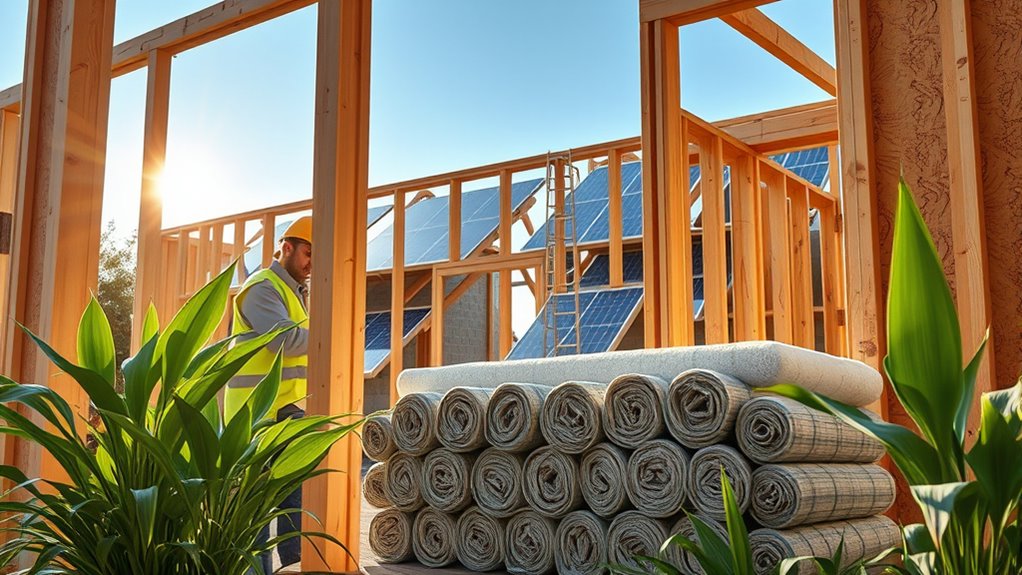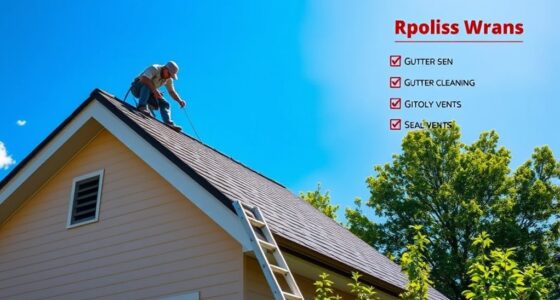In 2025, choosing eco-friendly insulation means focusing on natural fibers like sheep’s wool, hemp, or cotton, which are renewable and biodegradable. Recycled materials such as denim and plastic bottles also offer sustainable options that reduce waste. Look for products with low-VOC emissions, high thermal performance, and eco-certifications. Prioritize materials made through low-impact manufacturing processes. Keep exploring to discover how to select the best green insulation for your home’s comfort and environmental goals.
Key Takeaways
- Prioritize natural fibers like sheep’s wool, hemp, or cotton for biodegradable, chemical-free insulation options.
- Select recycled materials such as reclaimed denim or plastic bottles to reduce landfill waste and support circular economy.
- Ensure insulation has high R-values and low VOC emissions for optimal thermal performance and indoor air quality.
- Opt for manufacturing processes that use renewable energy and reduce emissions to minimize environmental impact.
- Check for eco-labels and certifications to verify the insulation’s sustainability, durability, and health benefits.
Natural and Renewable Fiber Insulation Options
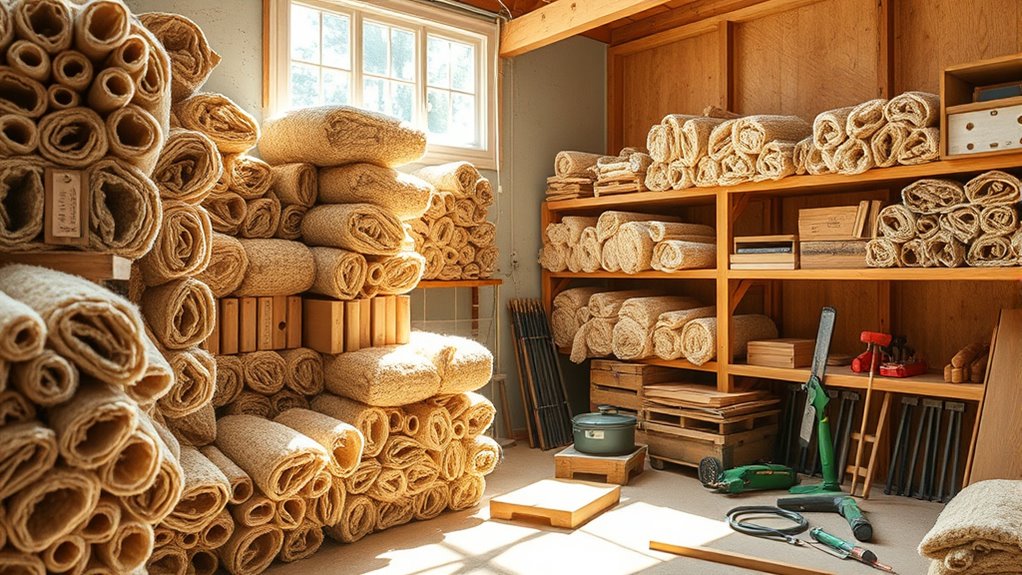
Natural and renewable fiber insulation options are excellent choices for eco-friendly homes. These materials, like sheep’s wool, hemp, and cotton, benefit from innovative insulation technologies that enhance their effectiveness while reducing environmental impact. They naturally trap air, providing excellent thermal resistance without harmful chemicals. Many governments offer incentives to encourage the adoption of such sustainable solutions, making these options more affordable. By choosing natural fibers, you support renewable resource use and lower your home’s carbon footprint. These materials are also biodegradable and safe for indoor air quality, aligning with eco-conscious living. With advancements in insulation tech and government support, integrating natural and renewable fiber options into your home becomes both practical and environmentally responsible. Additionally, understanding sound design principles can help you create a comfortable and sustainable living environment through better acoustic management.
Recycled and Reclaimable Materials for Sustainable Insulation

Recycled and reclaimable materials play a vital role in creating sustainable insulation solutions. Recycling innovations have made it easier to repurpose waste materials into effective insulation products, reducing landfill waste and conserving resources. For example, reclaimed denim and recycled plastic bottles now serve as eco-friendly insulations, cutting down on virgin material extraction. Reclaiming materials involves sourcing components that would otherwise be discarded, giving them new life in building applications. By choosing insulation made from recycled or reclaimable sources, you support a circular economy and lower your environmental impact. These materials often have lower embodied energy and contribute to greener building practices. Incorporating advanced fraud detection techniques can help ensure that transactions involving eco-friendly products are secure and trustworthy. Embracing recycling innovations and reclaiming materials helps you build more sustainable, eco-conscious structures for the future.
Low-Environmental-Impact Manufacturing Processes
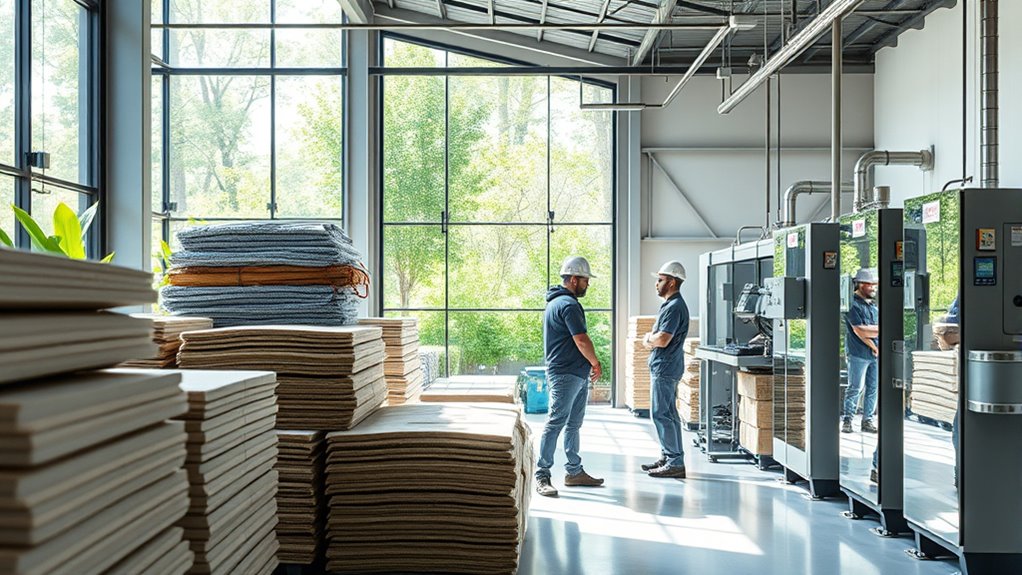
Manufacturing processes that minimize environmental impact are essential for sustainable insulation choices. By reducing industrial emissions, you help lower air pollution and greenhouse gases. Sustainable supply chain practices ensure raw materials are sourced responsibly, minimizing ecological damage. Look for manufacturers committed to eco-friendly methods, such as renewable energy use and waste reduction. Below is a quick overview of key features:
| Feature | Benefit | Example |
|---|---|---|
| Emission Controls | Lower air pollution | Reduced factory emissions |
| Renewable Energy Use | Decreases carbon footprint | Solar or wind-powered factories |
| Supply Chain Sustainability | Ensures responsible sourcing | Local, eco-friendly suppliers |
Implementing eco-conscious manufacturing techniques further supports the goal of reducing environmental impact and promoting healthier building materials.
Evaluating Thermal Performance and Eco-Friendliness
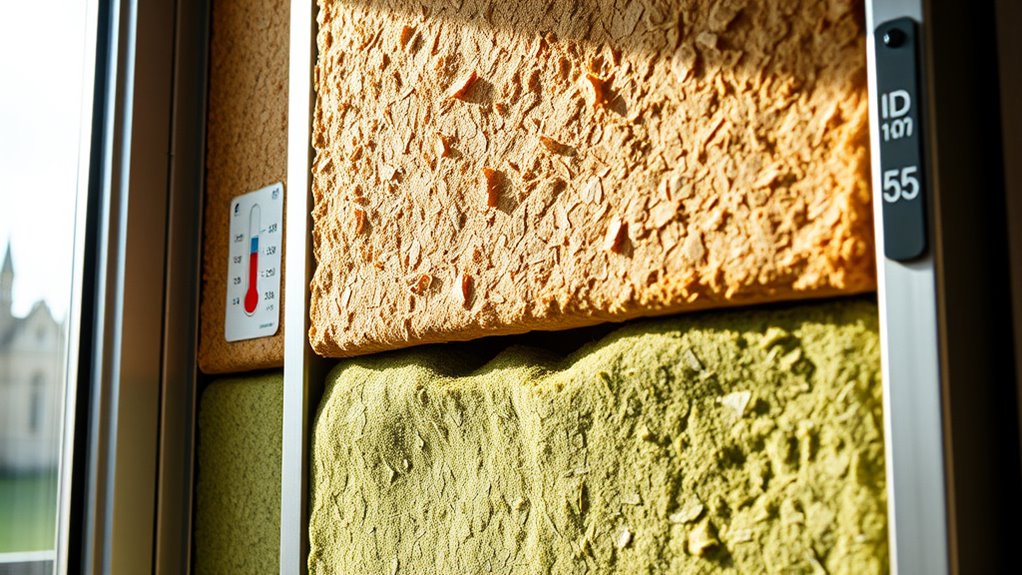
When choosing insulation materials, it’s vital to evaluate both their thermal performance and eco-friendliness to guarantee they meet your sustainability goals. Start by considering these factors:
- Thermal efficiency: Look for materials with high R-values to ensure better insulation and energy savings.
- Air quality: Opt for low-VOC options that won’t compromise indoor air quality or release harmful chemicals.
- Moisture resistance: Choose eco-friendly materials that resist moisture to prevent mold growth and maintain durability, reducing the need for replacements.
- Adaptability: Select materials that can evolve with technological advancements to ensure long-term sustainability and effectiveness.
Balancing these aspects ensures your insulation performs well while supporting eco-friendly living. By prioritizing thermal performance, air quality, moisture resistance, and adaptability, you make smarter choices that align with your environmental commitments.
Tips for Selecting the Right Green Insulation for Your Home
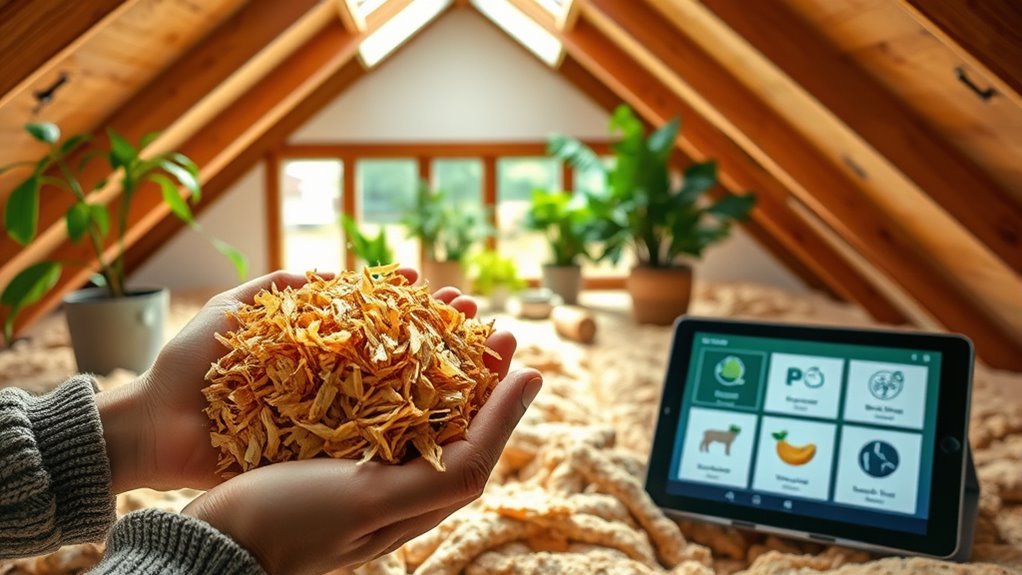
Choosing the right green insulation for your home involves more than just considering eco-friendliness; it also requires evaluating how well the material fits your specific needs. Focus on energy savings, as the right insulation can reduce your heating and cooling costs markedly. Look for options with high thermal performance to maintain consistent indoor temperatures. Additionally, prioritize indoor air quality—select materials that are low in volatile organic compounds (VOCs) and free from harmful chemicals. Consider the material’s durability and ease of installation to ensure long-term effectiveness. Don’t forget to check for certifications or labels that verify eco-friendly standards. By balancing energy efficiency, indoor air quality, and environmental impact, you’ll choose insulation that benefits both your home and the planet. Incorporating natural materials can also enhance the sustainability and overall comfort of your insulation choice.
Frequently Asked Questions
How Do Eco-Friendly Insulations Compare in Cost to Traditional Options?
When you compare eco-friendly insulations to traditional options, you’ll notice that the cost difference varies. Eco-friendly materials often have a higher initial cost, but the cost comparison shifts over time due to energy savings and durability. These materials offer significant economic benefits, including reduced utility bills and potential tax incentives. Overall, investing in eco-friendly insulation can provide long-term savings, making it a smart choice despite the upfront investment.
Are There Any Health Risks Associated With Natural Insulation Materials?
Some believe natural insulation materials pose health risks, but studies show they generally improve indoor air quality by reducing harmful chemicals found in synthetic options. You may worry about allergen exposure, but natural materials like wool and cellulose can help filter air and reduce dust. While minor risks exist if not properly installed or treated, overall, natural insulations are safer for your health, especially when properly maintained.
How Long Do Eco-Friendly Insulation Materials Typically Last?
Eco-friendly insulation materials usually have a solid durability lifespan, often lasting between 20 to 50 years, depending on the type and installation quality. You’ll find that maintenance requirements are generally low, but it’s good to inspect periodically for moisture or pests. Proper installation and occasional upkeep help guarantee your insulation retains its effectiveness over time, maximizing your investment and keeping your home comfortable for decades.
Can Eco-Friendly Insulation Be Recycled or Reused at the End of Its Life?
Your eco-friendly insulation’s end-of-life options are more promising than you might think. Many materials, like cellulose or recycled denim, can be recycled through specialized recycling processes, reducing waste considerably. Some have impressive reuse potential, allowing you to repurpose or recycle them easily. By choosing these sustainable options, you’re not just insulating your home but also championing a greener planet, making your impact truly monumental.
What Certifications Should I Look for When Choosing Green Insulation Products?
When selecting green insulation products, you should look for certifications to verify their eco-friendliness. Focus on eco label standards like ENERGY STAR, GreenGuard, and LEED, which ensure the material meets environmental and health criteria. These certifications help you identify insulation that’s sustainably produced, non-toxic, and energy-efficient. Always check for reputable third-party verification to guarantee you’re making an environmentally responsible choice for your home or project.
Conclusion
Choosing eco-friendly insulation is like planting a seed for a greener future. Every sustainable choice you make today helps nurture a healthier planet tomorrow. Just as a single seed grows into a mighty tree, your decision to select green materials can inspire lasting change. By prioritizing eco-conscious options, you become part of a larger movement—transforming your home into a sanctuary that supports both your comfort and the Earth’s well-being.
